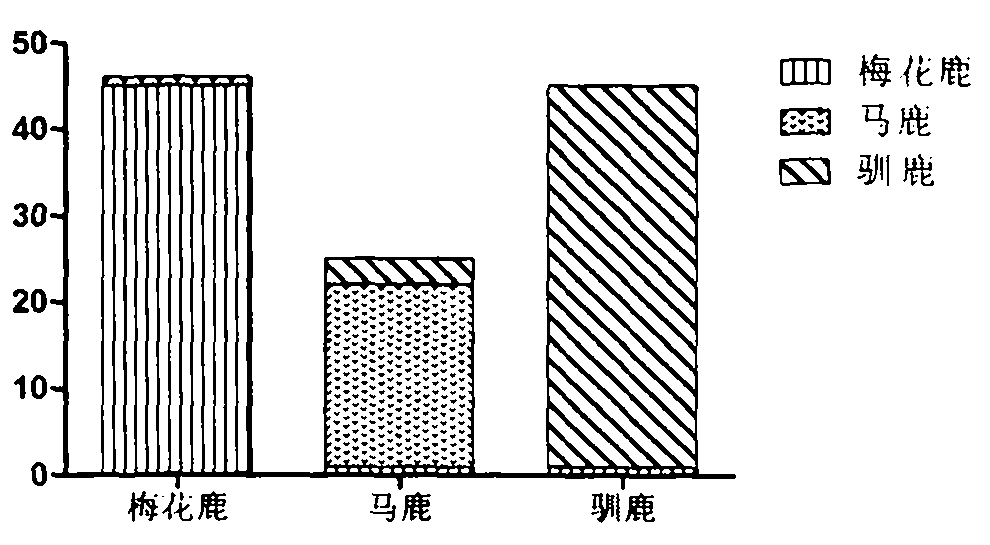Electronic nose technology based method for rapid identification of pilose antler ''authenticity''
An electronic nose and deer antler technology, which is used in material analysis, measuring devices, instruments and other directions by electromagnetic means, can solve the problems of long detection time, serious degradation of sample DNA, complicated and complicated process, etc. The effect of fast speed and high work efficiency
- Summary
- Abstract
- Description
- Claims
- Application Information
AI Technical Summary
Problems solved by technology
Method used
Image
Examples
Embodiment 1
[0017] Example 1 Comparative Analysis of velvet Genuine Products and Counterfeit Products Based on First Vector Feature Extraction
[0018] Each antler sample is injected and tested separately, as follows:
[0019] Treatment of experimental materials: take velvet antler into a petri dish, and wrap each one with newspaper. Put it in an oven at 40°C for 12 hours. On the one hand, it is dry and easy to crush, and on the other hand, it is easy to volatilize the alcohol residue in the process of cutting the velvet slices.
[0020] The settings of the electronic nose are as follows: injection volume 2500 μL, incubation time 500 s, incubation temperature 70 °C, acquisition time 200 s, delay time 400 s, stirring speed 250 rpm.
[0021] Six replicates were performed for each sample.
[0022] Use the maximum response value of each sensor for each sample in the sample set to build a library, and perform PCA and LDA (Figure-1) analysis. In the PCA analysis experiment, the acquired data...
Embodiment 2
[0023] Example 2 Comparative Analysis of Genuine Deer Antler and Counterfeit Products Based on Second Vector Feature Extraction
[0024] Each antler sample is injected and tested separately, as follows:
[0025] Treatment of experimental materials: take velvet antler into a petri dish, and wrap each one with newspaper. Put it in an oven at 40°C for 12 hours. On the one hand, it is dry and easy to crush, and on the other hand, it is easy to volatilize the alcohol residue in the process of cutting the velvet slices.
[0026] The settings of the electronic nose are as follows: injection volume 2500 μL, incubation time 500 s, incubation temperature 70 °C, acquisition time 200 s, delay time 400 s, stirring speed 250 rpm.
[0027] Six replicates were performed for each sample.
[0028] Use the maximum response value of each sensor for each sample in the sample set to build a library, and perform PCA and LDA (Figure-2) analysis. In the PCA analysis experiment, the acquired data wa...
Embodiment 3
[0029] Example 3 Electronic nose antler identification analysis second vector feature model verification
[0030]Extract the second vector feature data in the verification set, combine it with the second vector feature data in the sample set to build a database, and perform LDA analysis. A two-dimensional column chart (Figure-3) was established for the prediction results of each antler slice. From the figure, it can be concluded that the correct classification rates of sika deer, red deer and reindeer in the initial grouping cases were 97.82%, 84.0%, and 97.77%. The correct classification rate is 94.8%. In addition, this model also verified the difference between genuine sika deer and other kinds of velvet antler such as moose, sambar, Eld's deer, elk, etc., and the correct identification rate reached 83.23%-98.36%. It has better discrimination and recognition ability, and is suitable for popularization and application of deer antler identification.
PUM
 Login to View More
Login to View More Abstract
Description
Claims
Application Information
 Login to View More
Login to View More - R&D
- Intellectual Property
- Life Sciences
- Materials
- Tech Scout
- Unparalleled Data Quality
- Higher Quality Content
- 60% Fewer Hallucinations
Browse by: Latest US Patents, China's latest patents, Technical Efficacy Thesaurus, Application Domain, Technology Topic, Popular Technical Reports.
© 2025 PatSnap. All rights reserved.Legal|Privacy policy|Modern Slavery Act Transparency Statement|Sitemap|About US| Contact US: help@patsnap.com



